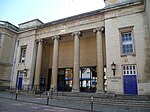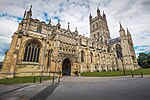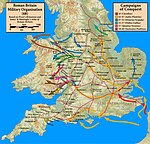Gloucester ( GLOST-ər) is a cathedral city and the county town of Gloucestershire in the South West of England. Gloucester lies on the River Severn, between the Cotswolds to the east and the Forest of Dean to the west; it is sited 19 miles (31 km) east of Monmouth and 17 miles (27 km) east of the border with Wales. Gloucester has a population of around 132,000, including suburban areas. It is a port, linked via the Gloucester and Sharpness Canal to the Severn Estuary.
Gloucester was founded by the Romans and became an important city and colony in AD 97, under Emperor Nerva as Colonia Glevum Nervensis.
It was granted its first charter in 1155 by Henry II. In 1216, Henry III, aged only nine years, was crowned with a gilded iron ring in the Chapter House of Gloucester Cathedral. Gloucester's significance in the Middle Ages is underlined by the fact that it had a number of monastic establishments, including St Peter's Abbey, founded in 679 (later Gloucester Cathedral); the nearby St Oswald's Priory, founded in the 880s or 890s; and Llanthony Secunda Priory, founded in 1136. The town is also the site of the siege of Gloucester in 1643, during which the city held out against Royalist forces in the First English Civil War.
A major attraction of the city is Gloucester Cathedral, which is the burial place of King Edward II and Walter de Lacy; it features in scenes from the Harry Potter films. Other features of interest include the museum and school of art and science, the former county jail (on the site of a Saxon and Norman castle), the Shire Hall (now headquarters of the County Council) and the Whitefield memorial church. A park in the south of the city contains a spa, a chalybeate spring having been discovered in 1814.
Economically, the city is dominated by the service industries and has strong financial, research, distribution and light industrial sectors. Historically, it was prominent in the aerospace industry.
In 1926, the Gloucestershire Aircraft Company at Brockworth changed its name to the Gloster Aircraft Company because international customers claimed that the name Gloucestershire was too difficult to spell. A sculpture in the city centre celebrates Gloucester's aviation history and its involvement in the jet engine.












